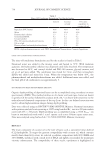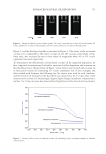687 Address all correspondence to Manuel Gamez-Garcia, mgamez-garcia@ashland.com Moisture in the Cuticle Sheath: Effects on Hair Mechanical and Cosmetic Properties MANUEL GAMEZ-GARCIA Ashland Specialty Ingredients, Bridgewater, New Jersey, USA (M.G-G.) Synopsis The role of moisture in the cuticle sheath has not been properly explored so far. In this paper, analysis and experiments indicate that moisture variations in the cuticle sheath have a significant impact on its shear and tensile modulus and, therefore, on the overall hair mechanical and cosmetic properties. Analysis shows that if there is an imbalance in the required moisture content in the cuticle cell inter- and intralayers, steep layer moduli mismatches and stress concentrations are generated across interfaces. Imbalances of this type often arise when the hair has very low levels of moisture or when it is transiently subjected to high temperatures, becoming more severe with tensile extensions. For instance, at high elongations and near the yield point, the intermediate filaments in the cortex undergo an alpha to beta transformation. This keratin phase transition occurs at both low- and high-moisture conditions and causes the cortex tensile modulus to decrease, allowing for higher deformations without severe stress buildup. In contrast, at high elongations, the cuticle sheath has no such stress dissipation mechanism, and high-stress concentrations appear across the cuticle cells. Therefore, moisture loss in the cuticle cells accompanied by extensions aggravate stress concentrations resulting in damage at the cuticle cell cement boundaries. INTRODUCTION When studying the physical and cosmetic behavior of hair, more effort should be placed on analyzing both cortex and cuticle sheath properties. Unfortunately, too often, more attention is given to the properties of the cortex, and those of the cuticle sheath are ignored. Such a biased approach can lead to the wrong conclusions. A typical example of this can be found in studies on hair moisturization. Very often, we tend to consider that the effects of moisture on the overall hair cosmetic properties depend solely on the moisture content of the cortex. In doing so, we neglect the role that moisture in the cuticle sheath may play in this endeavor. Incidentally, it should be mentioned that recently, the hair cosmetic community has started to realize that moisture in the cortex may have little or no correlation at all with the sensorial and subjective properties of moisturized hair (1). It is quite possible that the sensorial properties associated to hair moisturization depend less on the cortex moisture and more on the effects of moisture in the cuticle sheath. This is because of the cuticle sheath’s position at the hair surface. At this point, it is difficult to make a definitive assertion in this direction until more data and research elucidate this question. We can be certain that, in the future, studies in this direction will include J. Cosmet. Sci., 72, 687–696 (November/December 2021)
688 JOURNAL OF COSMETIC SCIENCE analysis of moisture in the cuticle sheath. This paper reports preliminary observations on this subject. However, before describing the experimental details of this report, it seems appropriate to review one of the most common patterns of hair damage that appears in most individuals, cuticle cell decementation, lifting, and buckling. These patterns are relevant because they are a form of cuticle cell delamination, and, as will be shown later, they are strongly dependent on moisture. Cuticle cell decementation and buckling usually appears in hair fibers at distances larger than 10 or 20 cm from the scalp, depending on the type of care the hair has received. In fact, this type of damage is so prevalent that it can be considered the initial indication of hair damage. It appears way before hair breakage or before the appearance of any other type of hair cortex physical trauma. Its ubiquitous nature and its relation to moisture demands a clear understanding, first, of how grooming practices lead to its formation, and, second, of its effects on hair sensorial properties. In this paper, experimental results associated to the former will show that cuticle cell decementation, delamination, and buckling are strongly related to the state of moisture in the cuticle cell layers. It will also be shown that this type of damage is usually associated to conditions involving any of the following repetitive processes: (1) cyclic tensile stresses involving elongations higher than 12% and (2) applications of thermal stresses accompanied by elongations lower than 5%. The first process will be frequently encountered by hair fibers during combing and tangling, especially when the hair is totally or partially wet and when poorly conditioned. The second process will result from blow drying or combing or when using hot irons both involve rapid dehydration of cortex and cuticle sheath. In this respect, it is worth mentioning the well-known fact that moisture loss in hair has a strong impact on its mechanical modulus. Water loss in hair usually is associated with dehydration of proteins in the matrix since the intermediate filaments (IFs) do not absorb water (2). Water loss from the cuticle cells also occurs, although it has not been studied as much and most certainly stems from the endocuticle, the cell membrane complex (CMC), and to a lesser extent from the exocuticle (2,3). As will be shown later, as the exocuticle, endocuticle, and CMC lose moisture at high temperatures, they become stiffer and change their mechanical moduli, compromising their response to mechanical stresses. METHODOLOGY The hair used in the experiments was Virgin Premium Grade Brown Caucasian from International Hair Importers. Two sets of hair fiber samples were subjected each to different thermal stress conditions. In the first set, a tensile deformation of 5% was applied to the hair fibers while they were simultaneously subjected to blow drying within a temperature range between 40 and 80°C a Diastron Tensile Tester was used to deform the fibers. In the second set, the hair fibers were hot ironed using temperatures between 160 and 220°C. Before thermal stress application, the hair fibers were equilibrated at different relative humidity conditions for 24 hours. Moisture equilibration was made in a glass bowl with a tray containing water saturated with various salts, depending on the moisture value required. When needed, cuticle cell lifting was produced by applying cyclic elongations using the method described elsewhere (3). The presence of delaminated, lifted, and buckled cuticle cells was readily detected by SEM and optical microscopy. A Hi-Scope KH-3000 from Hirox was employed to detect and analyze buckled cuticle cells via the colorful patterns
Purchased for the exclusive use of nofirst nolast (unknown) From: SCC Media Library & Resource Center (library.scconline.org)






































































































































